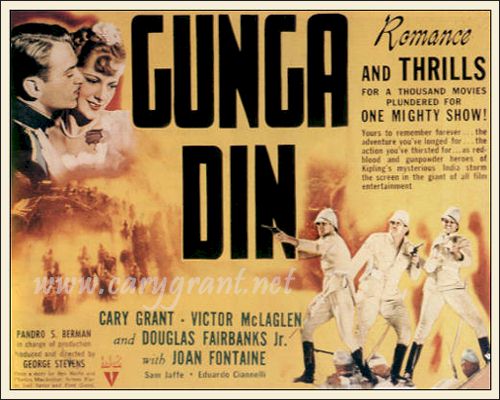

This newspaper drama had one character breaking ranks in order to get married.

When Hecht and MacArthur took over in 1936, they fashioned a tale that had the spirit of another Kipling story, Soldiers Three (1888). Additionally, they borrowed a plot element from their 1928 play, The Front Page. RKO’s involvement in the property went back to 1936 when they purchased the story from producer Edward Small. Small had earlier acquired the rights from Kipling’s widow and had commissioned William Faulkner to write a treatment. However, Faulkner’s early drafts bear little resemblance to the 1939 film. They were not the first writers to work on the project. However, the screenplay owes more to Ben Hecht and Charles MacArthur. It was inspired by the 1892 poem by Rudyard Kipling. Gunga Din transports us to a romanticized era during the British Empire. You’re a better man than I am, Gunga Din!” Gunga Din (Sam Jaffe) is the company water-bearer who dreams of being a soldier but must always follow behind. When treasure-hunting Cutter goes off in search of a golden temple, he and Gunga Din stumble into the meeting place of the Thuggees and their sinister Guru (Eduardo Ciannelli). Din escapes and brings word to the other sergeants, who must come to Cutter’s rescue. When an English cavalry patrol at Tantapur, India, gets wiped out, Sergeants Cutter (Grant), MacChesney (McLaglen), and Ballantine (Fairbanks, Jr.) ride in and fight a murder cult of Thuggees. Gunga Din will continue to influence new generations of fans and filmmakers. Screened again in its 75th anniversary, it is clear that Gunga Din has lost none of its audience appeal.Ĭary Grant, Victor McLaglen, and Douglas Fairbanks, Jr. play three soldiers hell-bent on making the world safe. Gunga Din‘s lasting influence can be seen decades later in 1984’s Indiana Jones and the Temple of Doom, which lifted many plot points from the earlier film. It’s the sort of mythic dream that Hollywood excelled at in its golden age. It’s a boy’s adventure about heroics that takes us back to our youth and rekindles old enthusiasms. Few films, then or now, have been able to match Gunga Din‘s combination of humor, derring-do, and humanity. We’re sounding the bugle for the “Films of 1939” and leading off with one of the greatest action films Hollywood ever produced. These sessions were usually enlivened by a few drinks to warm up the chatteringly chill desert night air that followed the blistering hot days.” ~ Douglas Fairbanks, Jr., The Salad Days George, Bob Coote, Cary, Joel Sayre, and I would sit up after dinner telling stories, discussing politics, and arguing about and/or rewriting scenes to be done the next day. Every day we worked in temperatures that sometimes rose to 110 in the shade. The director, principal actors, first cameraman (the award-winning Joe August), writer Joel Sayre, and senior technicians either had tents of their own or shared with one another. It took at least a month to build a tent city for hundreds of us to live in. According to the technical directors, the setting was much like India’s Northwest Frontier. “We spent many weeks in the California desert at Lone Pine, several hours’ drive from Los Angeles, close to the base of the Sierra Nevada Mountains.


GUNGA DIN SCREENWRITER CROSSWORD SERIES
Presented by the Pickwick Theatre Classic Film Series WHAT: GUNGA DIN: A 75th anniversary screening


 0 kommentar(er)
0 kommentar(er)
